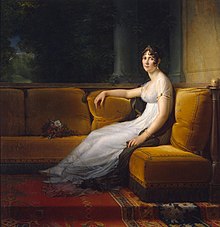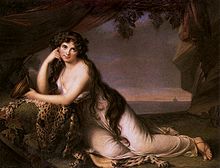Fashion à la grecque

As fashion à la grecque ( "Greek fashion", nor robe à la romaine , derogatory naked fashion or Nuditätenmode ) is known in the fashion of the Directoire and Empire (ie approximately the time from 1794 to 1811) has a strong anlehnende to antique models Women fashion. Characteristic are chemise , shirt dresses from almost transparent muslin with a very high fixed waist, a revealing neckline and short sleeves. Since muslin or the seldom used silk were very expensive fabrics, the fashion was limited to wealthier circles.
Although there was talk of nude fashion , they actually wore undergarments or, especially in France, flesh-colored jerseys .
The first reports of dresses à la grecque come from Venice and Paris in 1788.
The following are named as the background for the development of fashion:
- the interest in antiquity, which increased sharply at the time (also due to the finds in Pompeii )
- the “attitudes” of Emma Hamilton , representations of ancient figures as a living image in appropriate robes
- Suggestions from the painter Jacques-Louis David

Another possible origin of Greek fashion is the appearance of the dancer Maria Viganò in Vienna in 1793. These appearances, in which the dancer only wore skirts made of thin muslin over a flesh-colored leotard and thus appeared to be almost naked, caused a tremendous sensation and exerted considerable influence the fashion off. The contemporary Caroline Pichler explicitly writes:
“There was a noticeable impact on fashion in women's clothing. Our stiff, pleated suits gave way to lighter forms, the long waists with the tips of their bills in front and behind disappeared together with the bouffants and sieve skirts , which had gradually prepared an approach. The belt of the dress was no longer tied at the hips but under the breast; The powder was gradually abolished, the high-heeled shoes thrown off, the whole clothing came closer to nature and actually to the Greek taste, in which sense one stepped on and on in the following years, up to scarcity in clothing that hardly a fold left so that the most precise designation of the body shape underneath seemed to be the real purpose and fame of this fashion. This included arms that were really or apparently bare under jerseys, bare shoulders, laced shoes that imitated the Kothurn , rich bracelets, not just on the forearm as usual, but above the elbow; hair cut off and in short curls or, if it remained long, tied in a bun at the back of the head - short, as much as possible, a Greekizing costume. "
literature
- Carsten Jöhnk: “The nasty French nudity.” Caricatures on nude fashion around 1800. In: Adelheid Rasche, Gundula Wolter (Ed.): Ridikül! Fashion in Caricature 1600 to 1900. Catalog of the exhibition in the Art Library, Staatliche Museen zu Berlin from December 5, 2003 to February 15, 2004. SMB-DuMont, Berlin & Cologne 2003, ISBN 3-8321-7388-9 , pp. 69-78
- Ingrid Loschek: Reclam's fashion and costume lexicon . 5th edition, Reclam, Stuttgart 2005, ISBN 3-15-010577-3 , p. 221

